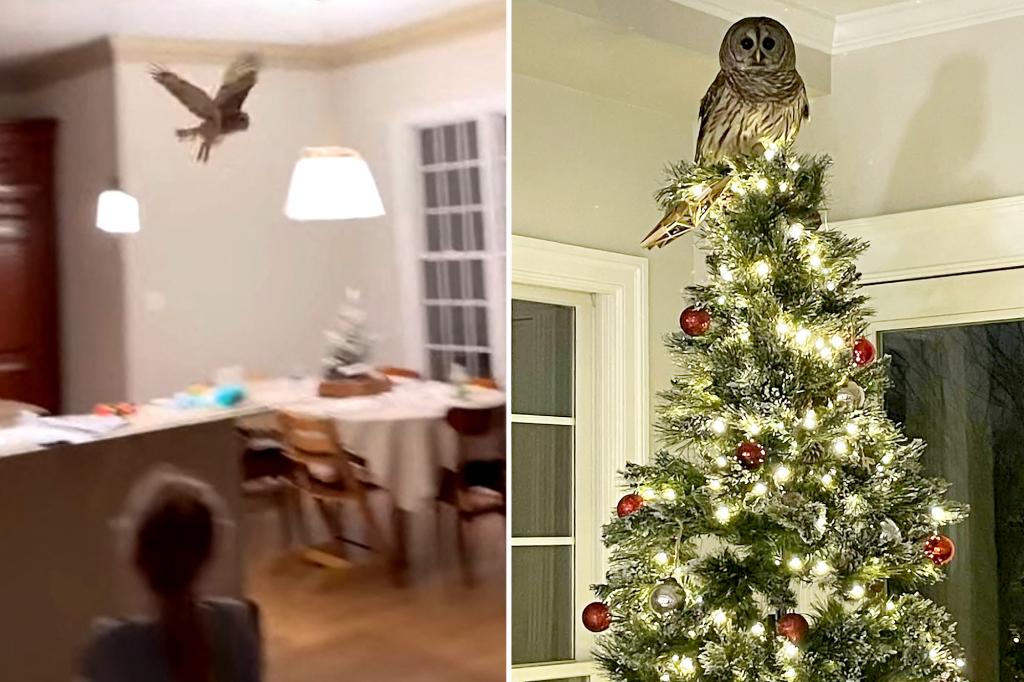The tranquility of a Virginia home was unexpectedly interrupted by a unique Christmas visitor: a barred owl, a creature of the night, descended the chimney and perched atop the family’s Christmas tree, creating a magical, albeit slightly chaotic, holiday moment. The striking image of the owl, captured in a photograph that quickly went viral, depicts the bird with its intense black eyes staring directly at the camera, amid the festive decorations, an unexpected ornament of nature amidst the glitter and gleam. This whimsical intrusion by the wild into the domestic sphere generated a mix of surprise, delight, and a touch of the surreal, epitomizing the unpredictable charm of nature.
The homeowner, Savannah Burgoyne, first encountered the owl not on the tree but on her baby’s highchair in the kitchen, a rather incongruous setting for the nocturnal raptor. Having startled the bird from its initial perch, the owl, perhaps seeking a more suitable vantage point, then gracefully flew to the top of the Christmas tree, dislodging the star in the process to accommodate its considerable size. The tree, already a symbol of holiday cheer, became an even more extraordinary spectacle with the addition of this live, feathered adornment. The family’s six-year-old daughter was particularly enchanted by the owl’s presence, adding to the whimsical, storybook quality of the incident.
Barred owls, known for their distinctive hooting calls, are native to eastern North America, their calls often interpreted as sounding like the phrase “who cooks for you?” This particular owl, having inadvertently entered the home through the chimney, likely found itself disoriented and seeking an escape route. The Christmas tree, with its towering height and branches, probably offered a semblance of security and a familiar perch reminiscent of its natural habitat. The choice of the Christmas tree as a temporary refuge highlights the adaptability of wildlife, even in unexpected circumstances, and the sometimes humorous intersection of the natural world with human environments.
The incident, while surprising, serves as a reminder of the close proximity of wildlife to our homes, especially in suburban or semi-rural areas. Chimneys, while providing warmth and ventilation for homes, can also inadvertently become entry points for wildlife, particularly birds, bats, and squirrels. It is essential for homeowners to take preventative measures, such as installing chimney caps or screens, to deter animals from entering and potentially becoming trapped or causing damage. In this case, the owl’s intrusion, while disruptive, ended without harm to the bird or the family.
Following the unexpected visit, local authorities were contacted to safely remove the owl from the home and return it to its natural habitat. This intervention ensured the owl’s well-being and minimized the stress associated with its confinement within a human dwelling. The successful release back into the wild serves as a positive outcome, underscoring the importance of human intervention in assisting wildlife that finds itself inadvertently trapped or displaced. The experience, while unusual, provided a valuable learning opportunity about coexisting with wildlife and the importance of taking preventative measures to avoid future encounters.
The story of the owl in the Christmas tree transcends a simple anecdote of a curious animal encountering a human environment. It embodies the unexpected magic and wonder that can arise from the intersection of nature and human life. The image of the owl perched amidst the festive decorations resonates with a sense of whimsy, capturing a moment of unexpected beauty and highlighting the unpredictable nature of the world around us. The incident also serves as a gentle reminder of our interconnectedness with the natural world, even in the midst of our busy, modern lives. The owl, in its brief but memorable visit, brought a touch of the wild and a sprinkle of holiday magic into the Burgoyne home, leaving behind a story to be cherished and retold for years to come.

